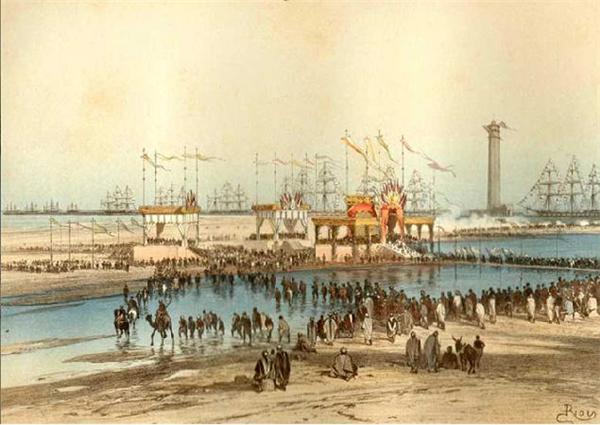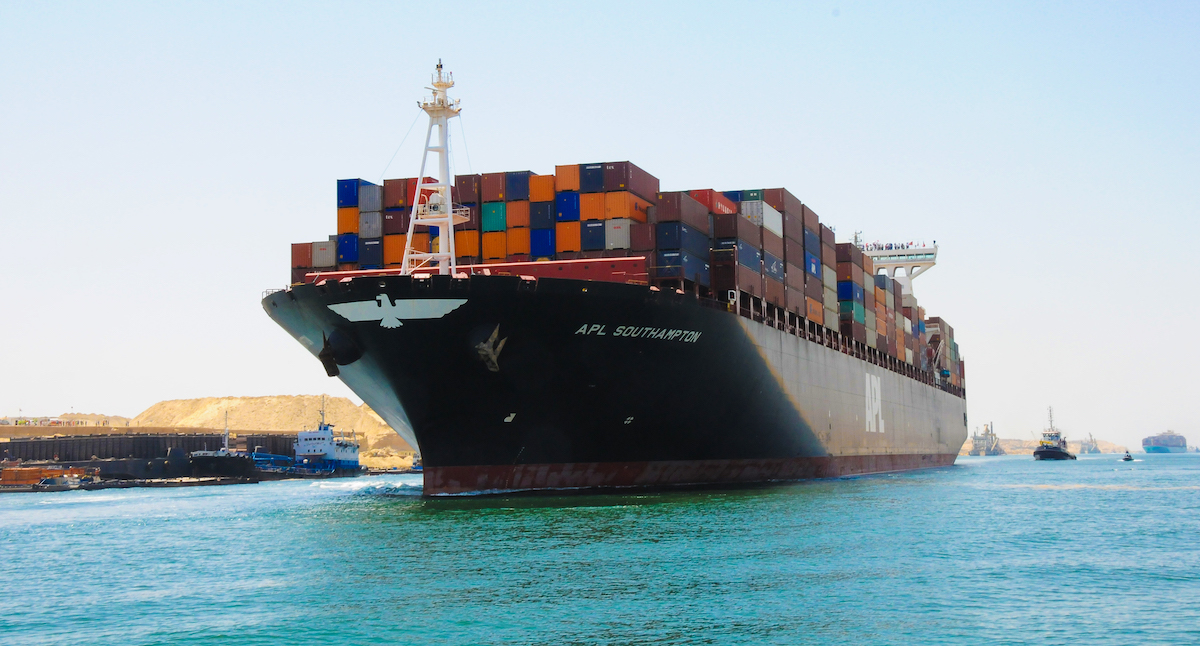ISABEL RUBIO ARROYO | Tungsteno
On 23 March 2021, the Ever Given, one of the world's largest cargo ships, became wedged in the Suez Canal. The blockage of this strategic waterway halted traffic in what is now one of the busiest trade routes on the planet. Its inauguration back in 1869 changed international maritime traffic, but the history of infrastructure goes back 40 centuries—in Pharaonic Egypt they were already dreaming of a canal linking the Red Sea with the Mediterranean.
The ancient Egyptians fantasised about building canals to transport huge blocks of stone to construct pharaonic monuments and for warships to pass through, according to the Suez Canal Authority. The so-called Canal of the Pharaohs was first dug during the reign of Pharaoh Senusret III around 1850 BC. That canal ran from the Red Sea to the Nile River, but did not reach the Mediterranean.

The Suez Canal is more than 160 kilometres long and 300 metres wide. Credit: Suez Canal Authority.
That waterway was abandoned and rebuilt several times over the following centuries. Some of the rulers who attempted to reopen the canal or extend its reach were Necho II (610 BC), the Persian King Darius (522 BC), Ptolemy II (285 BC), the Emperor Trajan (117 AD) and Amr ibn al-As (640 AD). Their plans had human costs: for example, it is estimated that more than 100,000 men died in the attempt to reopen the canal under Necho II.
From Napoleon Bonaparte to a group of French intellectuals
The first efforts to build the modern canal, the one directly linking the Mediterranean to the Red Sea, came under Napoleon Bonaparte. In the late 18th century, the French general led an expedition to conquer Egypt. Bonaparte hoped that the construction of this waterway would create a trading headache for the British. The project began in 1799 but the French engineers made an error: they estimated that the Red Sea was about 10 metres higher than the Mediterranean. This miscalculation led them to abandon the idea.

Celebration of the Suez Canal completion in 1869. Credit: Suez Canal Authority.
A few decades later, in 1833, a group of French intellectuals associated with the Saint-Simonianism movement arrived in Cairo and took another look at the project. When some of them returned to France, they set up an association to study once again whether the canal, in addition to revolutionising world trade, was feasible. It was then that they realised that such a difference in the level of the two seas did not exist. In other words, it was not true that the Red Sea was some 10 metres higher than the Mediterranean. Even so, the idea of the canal did not gain traction at the time.
In 1854, the French diplomat and engineer Ferdinand Marie, Viscount de Lesseps, managed to attract the interest of the Egyptian governor Mohamed Sa'id Pasha. The Frenchman thus became responsible for setting up and directing the Universal Company of the Maritime Canal of Suez. This body would be responsible for linking the two seas and was granted the right operate the canal for 99 years. After that, ownership would revert to the Egyptian government.
A key artery in world shipping
The pilot study estimated that a total of 2,613 million cubic feet of earth would have to be moved. Excavation of the Suez Canal began in 1859. After a few construction halts, it was finally inaugurated and opened to international maritime traffic ten years later. The harsh climate and working conditions on this iconic engineering feat resulted in at least 20,000 deaths. The construction methods used centuries ago to build other major infrastructure such as the pyramids in Egypt or the Great Wall of China also caused many deaths.

The Suez Canal carries virtually all container trade between Asia and Europe. Credit: Suez Canal Authority.
The completion of the canal was a cause for celebration. In Port Said, a port city in north-eastern Egypt where the Suez Canal is accessed from the Mediterranean, some 6,000 people attended a ball that also featured fireworks. Among the attendees were several heads of state. For example, the Emperor of Austria, the Prince of Wales, the Prince of Prussia, and the Prince of the Netherlands.
The Suez Canal, which is now owned by the Egyptian government, is more than 160 kilometres long, 300 metres wide and 24 metres deep. It is undoubtedly one of the world's main shipping arteries, carrying around 10% of world trade and virtually all container trade between Asia and Europe. Its success lies in the fact that it is the fastest crossing from the Atlantic Ocean to the Indian Ocean: it takes between 12 and 16 hours for a ship to pass through the canal. In fact, it serves to shorten the journey between Asia and Europe by some 7,000 kilometres (and between seven and nine days).
· — —
Tungsteno is a journalism laboratory to scan the essence of innovation. Devised by Materia Publicaciones Científicas for Sacyr’s blog.
